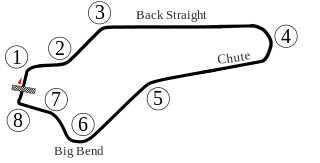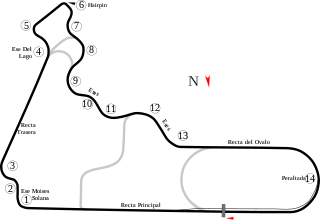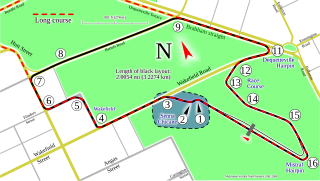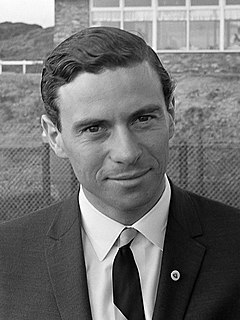
The 1962 United States Grand Prix was a Formula One motor race held on October 7, 1962, at the Watkins Glen Grand Prix Race Course in Watkins Glen, New York. It was race 8 of 9 in both the 1962 World Championship of Drivers and the 1962 International Cup for Formula One Manufacturers. The 100-lap race was won by Lotus driver Jim Clark after starting from pole position. Graham Hill finished second for the BRM team and Cooper driver Bruce McLaren came in third.

The 1968 United States Grand Prix was a Formula One motor race held on October 6, 1968, at the Watkins Glen Grand Prix Race Course in Watkins Glen, New York. It was race 11 of 12 in both the 1968 World Championship of Drivers and the 1968 International Cup for Formula One Manufacturers. The 108-lap race was won by Matra driver Jackie Stewart after he started from second position. Graham Hill finished second for the Lotus team and Honda driver John Surtees came in third. This was the debut race of the future world champion Mario Andretti.

The 1987 Belgian Grand Prix was a Formula One motor race held on 17 May 1987 at the Circuit de Spa-Francorchamps, Spa. Contested over 43 laps, the race was the 45th Belgian Grand Prix, the 33rd to be held at Spa and the fourth since the circuit was redeveloped in 1979, and the third race of the 1987 Formula One season.

The 1987 Mexican Grand Prix was a Formula One motor race held at Autodromo Hermanos Rodriguez on October 18, 1987. It was the fourteenth round of the 1987 Formula One season. It was the 11th Mexican Grand Prix and the second since the Autódromo Hermanos Rodríguez was renovated and returned to the World Championship calendar.

The 1988 San Marino Grand Prix was a Formula One motor race held at Imola on 1 May 1988. The 60-lap race was the second round of the 1988 Formula One season. Ayrton Senna scored his first victory for the McLaren team, with turbocharged Honda-powered cars sweeping the top three positions.

The 1989 United States Grand Prix was a Formula One motor race held on June 4, 1989, in Phoenix, Arizona.

The 1989 Italian Grand Prix was a Formula One motor race held at Monza on 10 September 1989. It was the twelfth race of the 1989 Formula One season.

The 1990 Brazilian Grand Prix was a Formula One motor race held on 25 March 1990 at Interlagos. It was the 19th Brazilian Grand Prix and the ninth to be held at Interlagos. The São Paulo circuit had not held the Grand Prix since 1980 and the circuit was extensively renovated with the circuit itself almost halved in length. The race was contested over 71 laps of the four kilometre circuit, for a race distance of 307 kilometres.

The 1992 Monaco Grand Prix was a Formula One motor race held on 31 May 1992 at the Circuit de Monaco. It was the sixth race of the 1992 Formula One World Championship.

The 1999 Australian Grand Prix was a Formula One motor race held on 7 March 1999 at the Melbourne Grand Prix Circuit in Albert Park, Melbourne, Australia. The 57-lap race was the first round of the 1999 Formula One season – the 50th World Championship season in the history of Formula One.

The 2000 German Grand Prix was a Formula One motor race held on 30 July 2000 at the Hockenheimring near Hockenheim, Germany. It was the eleventh round of the 2000 Formula One season and the 62nd German Grand Prix. The 45-lap race was won by Ferrari driver Rubens Barrichello after starting from 18th position. Mika Häkkinen finished second for the McLaren team with teammate David Coulthard third.

The 2001 British Grand Prix was a Formula One motor race held on 15 July 2001 at Silverstone in Northamptonshire, England. It was the eleventh race of the 2001 FIA Formula One World Championship.

The 1988 FIA Formula One World Championship was the 42nd season of FIA Formula One motor racing. It featured the 1988 Formula One World Championship for Drivers and the 1988 Formula One World Championship for Constructors, which were contested concurrently over a sixteen-race series that commenced on 3 April and ended on 13 November. The World Championship for Drivers was won by Ayrton Senna, and the World Championship for Constructors by McLaren-Honda. Senna and McLaren teammate Alain Prost won fifteen of the sixteen races between them; the only race neither driver won was the Italian Grand Prix, where Ferrari's Gerhard Berger took an emotional victory four weeks after the death of team founder Enzo Ferrari. McLaren's win tally has only been bettered or equalled in seasons with more than sixteen races; their Constructors' Championship tally of 199 points, more than three times that of any other constructor, was also a record until 2002.

The 1987 FIA Formula One World Championship was the 41st season of FIA Formula One motor racing. It featured the 1987 Formula One World Championship for Drivers and the 1987 Formula One World Championship for Constructors, which were contested concurrently over a sixteen-race series that commenced on 12 April and ended on 15 November. The World Championship for Drivers was won by Nelson Piquet, and the World Championship for Constructors by Williams-Honda. The season also encompassed the Jim Clark Trophy and the Colin Chapman Trophy, which were respectively contested by drivers and constructors of Formula One cars powered by naturally aspirated engines.
The 1968 Formula One season was the 22nd season of the FIA's Formula One motor racing. If featured the 19th FIA World Championship, which commenced on 1 January 1968, and ended on 3 November after twelve races, and numerous non-championship races.
The 1960 Formula One season was the 14th season of the FIA's Formula One motor racing. It featured the eleventh FIA World Championship of Drivers, the third International Cup for F1 Manufacturers and numerous non-championship Formula One races. The World Championship commenced on 7 February 1960 and ended on 20 November after ten races. Jack Brabham won his second consecutive title with his Cooper team defending its constructors' title.

The Adelaide Street Circuit is a temporary street circuit in the East Parklands adjacent to the Adelaide central business district in South Australia, Australia.

The 2007 British Grand Prix was the ninth race of the 2007 Formula One season. It was held on 8 July 2007 at the Silverstone Circuit. The race was won by Kimi Räikkönen after overtaking pole position driver Lewis Hamilton during the first round of pit stops. Second place was taken by Fernando Alonso and Hamilton was third.

The McLaren MP4-26 was a Formula One racing car designed by McLaren for the 2011 Formula One season. It was driven by Lewis Hamilton and Jenson Button, the 2008 and 2009 World Drivers' Champions, respectively. The car was launched on 4 February at Potsdamer Platz located in Berlin, Germany, shortly after the first test session of the season in Valencia. McLaren test driver Gary Paffett, Lewis Hamilton and Jenson Button drove an interim version of the car's predecessor, the MP4-25 at the first tests to get experience with the final tyre compounds provided by new tyre supplier Pirelli. Right before the 2011 Singapore Grand Prix, McLaren signed a new sponsor: Lucozade and the logo replaced the Johnnie Walker logo on the sides of the rear wing, thus shifting the Johnnie Walker logo to the back of the rear wing, which changed from red to silver in colour.


















